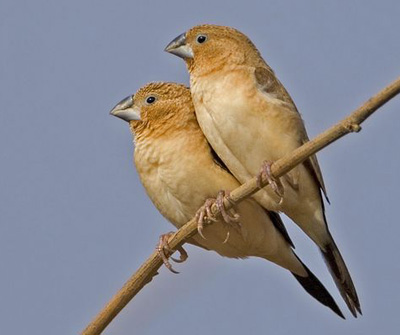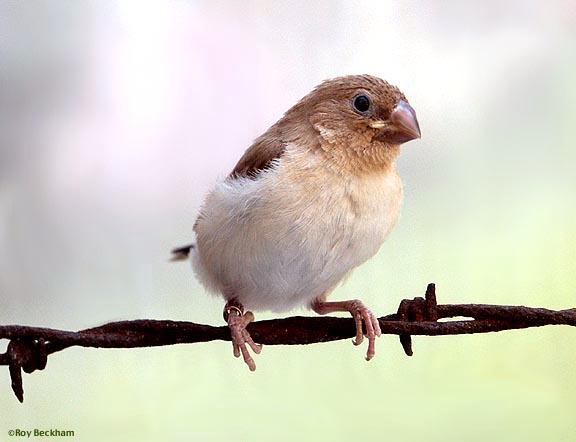
Lonchura cantans
SUBFAMILY
Lonchurinae
TAXONOMY
Loxia cantans Gmelin, 1789.
OTHER COMMON NAMES
English: Warbling silverbill, black-rumped silverbill, silverbill;
French: Capucin bec-d’argent; German: Silberschnдbelchen;
Spanish: Monjita Pico-de-plata.
PHYSICAL CHARACTERISTICS
3.9–4.5 in (10–11.5 cm). Sexes indistinguishable; brown, belly
white, rump and tail black. Juveniles have slightly paler underparts.
DISTRIBUTION
Southern Mauritania, east to Eritrea, south to northeastern
Tanzania. Two Asian populations, one in southern Saudi Arabia
and western Yemen, and one in southern Oman. Introduced
populations are established in Hawaii and Puerto Rico.
HABITAT
Can be found in dry savanna, thorn scrub, acacia woodland,
semi-desert, and inhabited or cultivated areas, usually near a
water source.
BEHAVIOR
This highly social species can be found in large, often dense,
flocks. The call note is a sharp “cheep” or “tseep” while the
song is a series of rising and falling trills for which it is sometimes
called the warbling silverbill.
FEEDING ECOLOGY AND DIET
Feeds on grass seeds picked from the growing plant or off the
ground. Although it has been reported to eat aphids, insects are
not a major part of its diet. This has been supported by captive
birds, which rear their young solely on vegetable matter.
REPRODUCTIVE BIOLOGY
Uses old weaver nests or sometimes builds a round nest of grass
where three to six white eggs are incubated for 11–13 days.
CONSERVATION STATUS
CITES: Appendix III. Not considered threatened by the IUCN.
SIGNIFICANCE TO HUMANS
Often found near human settlements, sometimes nesting in the
eaves of houses. This species is commonly found in aviculture.
Other popular Animals
Photo Gallery of - African silverbill




 Animalia Life
Animalia Life